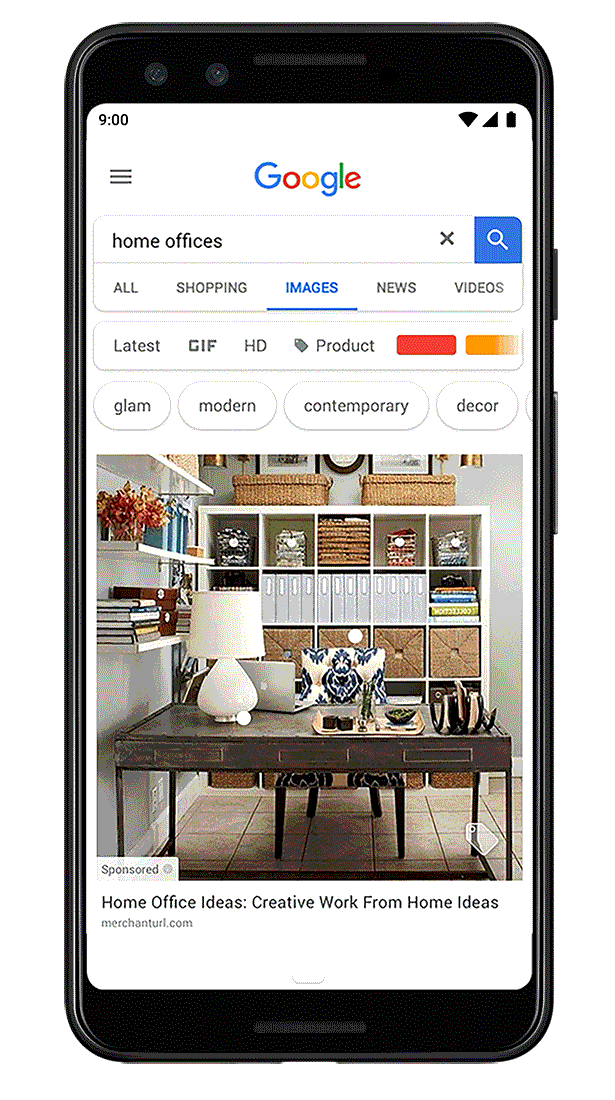Google wants to become your digital shopping catalog through shoppable ads.
The company on Tuesday said it is testing a new format on a small percentage of traffic with select retailers. Merchants can highlight multiple products available for sale within a sponsored ad among Google Images results.
Google is testing this approach on broad queries surfacing on searches like “home office ideas,” “shower tile designs” and “abstract art.” The approach is similar to strategies used on Instagram and Pinterest to encourage more shopping in response to search results.
Consumers will see a price tag icon on certain ads. The display shows details such as the price, the brand and other information. Consumers can tap on the price tag to check the websites and place an order directly.

There’s no word on when the feature is supposed to roll out generally. However, it will roll out to more categories and retailers in the coming months, according to Google.
The new shopping feature arrived nearly a year after Google introduced Shopping Actions, which linked search results to its retail partners. The shoppable images feature is Google’s latest effort to give advertisers more benefits from Showcase Shopping ads.
It offers shoppers a richer and more inspirational visual experience, according to Surojit Chatterjee, Google’s vice president for product management and shopping.
The introduction of shoppable ads will have a strong impact on e-commerce competition overall, said Ruba Aramouny, strategic director of Solid Marketing. Currently, social media and Google serve as discovery platforms.
“In the next few years, product discovery, selection and purchase will all happen on the same platform. While this means that retailers will have less control over the buyer shopping experience, they have to adjust to this change,” she told the E-Commerce Times.
Pros for Google
The big winners for this new shoppable image feature are Google and retailers, Aramouny added. It gives Google an additional way of selling ad placements to their advertisers.
“This means that the giant can now monetize all of the traffic that used to go to Google image search without seeing any ads,” she said. “The retailers who will benefit from this most are the ones who have the know-how to use the full capabilities of Google ads and merchant center.”
Ultimately, shoppable ads make search experiences more relevant and satisfying for Google, its advertisers and consumers. However, their introduction represents a big change, said Apu Gupta, CEO of Curalate. At the heart of this new format is a content type not typically seen on Google — lifestyle content.
“Google’s traditional Product Listing Ads are optimized for a person who has a specific item in mind. As a result, the images in those ads were just of individual products on dull backgrounds, so you could quickly verify that you had found the product you intended to find,” he told the E-Commerce Times.
Shopping is not solely about intent. It is also about discovery. By bringing inspirational lifestyle content into search results and making that content shoppable, Google can help you stumble across things you never knew you needed in your life, Gupta said.
Dueling Strategies
Both Google and Instagram aim to make it easy to upload a merchant’s entire catalog to their respective platforms so control ads are merchandised within each platform, according to BJ Cook, CEO of Digital Operative. They both do it through a merchant center via a product feed.
“While Google is in step one in the right direction, Pinterest has already been testing shoppable images and is now going to let you shop by brand, really setting a brand up with a mini-storefront, e-commerce popup shop in their platform. It’s really a step two for Pinterest,” he told the E-Commerce Times.
However, Google and Instagram have a very different approach to discovery, noted Curalate’s Gupta. Instagram is still primarily a feed-driven discovery experience. Google is more question-based.
Consumers on Instagram scroll through things without specific intent and stumble across things that capture your attention, explained Gupta. With Google, your starting point is essentially a question for which consumers are seeking an answer.
“In some cases, it is a really specific question, and in other cases, it is broader. While both platforms will now make use of shoppable lifestyle content and cause other ad tech companies to follow suit, what triggers that content to appear is very different,” Gupta said.
Impact on E-commerce Strategy
The retailer’s challenge will be to generate repeat purchases and build brand loyalty after a customer has made that initial purchase from social media or Google, said Aramouny. That is the only way they will be able to set themselves apart from competing stores that offer similar products.
A bigger challenge for e-commerce merchants will be figuring out how to introduce consumers to things they never knew existed. That is critical for the continued growth of e-commerce, added Gupta.
“Virtually every company that sells online today has repositories of great lifestyle content. The problem is the vast majority of these companies don’t think about how to leverage this content for sales. They’ve primarily used this content for branding,” he said.
“Companies who understand that content can do more will take advantage of these new formats and will win as they place a higher focus on content’s role in driving sales,” Gupta predicted.
Google, Pinterest and Instagram all have huge user bases to test shoppable ads in image searches, but Google’s user base is by far the biggest and most diverse, Apptimize CTO Nancy Hua said about Google’s potential for influencing e-commerce in general.
“Google’s dominance allows them to test and target more effectively across different demographics and use cases to learn more about how different users will behave in different contexts,” she told the E-Commerce Times. “This is going to be a profitable channel for them, but they have to test to figure out if it’s profitable enough to be worth the effort.”
It Depends
How successful the shoppable ads will be for Google depends on several variables. The fact that other social media outlets may be a step or two ahead of Google is no guarantee of a better implementation.
Google’s shoppable ads open up a great opportunity for new and unknown brands and retailers to get their inventory in front of new shoppers, said Marcel Hollerbach, CMO of Productsup.
“We have seen success on Pinterest Shopping and Instagram Shopping, so I’m excited to see how brands and retailers will adapt to Google’s new product,” he told the E-Commerce Times.
It will be compelling to see how Instagram and Google will stack up, as Google excels in search optimization while Instagram users tend to have a tight-knit relationship with the brands with which they follow and engage, Hollerbach said.
Advertising Makeover
The challenge for Google will be whether it can make a user interface that is not annoying to users, and has accurate enough recognition of objects in images so that users trust it before giving up on the feature altogether, suggested Eli Finkelshteyn, CEO of Constructor.io.
“Google’s dominance in general image search and users’ lack of other image searching options give the company a big advantage and the ability to try things,” he told the E-Commerce Times, “but they will still have to be careful about not leaving an initial bad taste in their users’ mouths that will be hard to wash out, even if the technology improves in the future.”
What Google is doing is interesting, inevitable, and fits tightly with commerce’s general march toward contextual commerce, he said.
The future of advertising will focus on when consumer attention is on something of value, like a product image, added Darin Archer, CMO of Elastic Path.
“By bringing the ad to a Google image search, brands can reach consumers at the beginning of their purchase journey,” he told the E-Commerce Times. “By then decreasing friction between viewing an ad and making a purchase, Google is allowing brands to streamline the commerce experience outside of owned channels.”
























































Social Media
See all Social Media